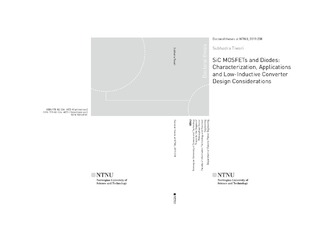| dc.description.abstract | The future power electronic system trends are: higher efficiency, higher power density, higher operating temperature and lower operation cost of power electronic converters. The emerging wide-bandgap (WBG) semiconductor material, especially silicon carbide (SiC), exhibits outstanding inherent properties that promise the potential to meet the subsequent growing demands. SiC enables the development of power devices capable of switching efficiently even at higher voltages and temperatures compared to the matured and well-established Si technology of today. Nonetheless, parasitic inductance and capacitance in the switching circuit are limitations for fully unleashing the fast-switching potential of these devices. The objective of this research is to evaluate what the state-of-the-art SiC devices, particularly SiC MOSFETs, offer at present and what can be done for better realizing their high switching-speed capability.
First, to assess the fast dynamic characteristics of SiC devices with a high degree of accuracy, measurement probes and oscilloscope with adequate bandwidth along with low-inductive connections are adopted. Switching characterization was conducted via doublepulse test in hard-switched as well as in resonant topology. Based on the measurement results, it is recommended to use a realistic topology for the precise assessment of switching losses in SiC devices.
Second, the state-of-the-art SiC MOSFET modules are examined to determine how fast they switch compared to the class-leading IGBT modules, given that they are packaged in the standard plastic housing. Measurement results revealed that the maximum dv/dt and di/dt rates that SiC MOSFET achieves are: 20 V/ns and 11 A/ns at 600 V bus voltage and 120 A load current. Si IGBT, on the other hand, achieved 17 V/ns and 12 A/ns when switched at similar conditions. According to this result, it can be inferred that dv/dt and di/dt rates that SiC MOSFET reaches are not as revolutionary as its intrinsic properties can potentially offer. In fact, this outcome can be attributed to the higher internal gate resistance that manufacturers use for avoiding oscillation during turn-off and the higher package inductance. In order to know what else can be achieved using SiC MOSFET, the body-diodes of the state-of-the-art SiC MOSFETs (both planar and trench technologies) were inspected. A particular focus was put on di/dt during the second-half of the recovery, keeping di/dt on the first-half of the recovery constant for all the devices being tested. Experimental outcomes revealed that the body-diodes in new generation SiC MOSFETs are as good as SiC junction barrier Schottky (JBS) diodes from the switching point of view. Nonetheless, the forward voltage drop is higher approximately by a factor of 3 compared to unipolar SiC Schottky diodes. Based on this information and the research conducted by another team, which confirmed that the body-diodes in new SiC MOSFETs do not create reliability issues anymore like those seen in the initial generation SiC MOSFETs, it is concluded that the body-diodes in SiC MOSFETs work effectively as freewheeling diodes.
Third, SiC MOSFETs are evaluated in three different key applications. One of those applications is a 240 kW back-to-back connected three-phase, two-level voltage source converter for motor drive, which disclosed that, for the same converter power loss, the switching frequency in an all-SiC-based converter can be increased by six times compared to that of an all-Si-based converter. Another application is an 80 kW single-phase, full-bridge inverter for induction heating applications, which proved an efficiency of 99.3% when switched at 200 kHz. SiC DioMOS, where MOSFET and diode are fabricated in a single chip, was the device under test and the inverter loss was measured via calorimetric method in this case. Finally, a 1 kW power factor correction rectifier is evaluated employing SiC MOSFET and SiC JBS diode in boost stage. A peak efficiency of 97.2% was achieved when switched at 250 kHz satisfying the 80 PLUS regulation throughout the entire load range. Moreover, EMI measurements revealed that the rectifier satisfies CISPR 11 Class B limits. Furthermore, when the switching frequency was increased from 66 to 250 kHz, the size of boost inductor was reduced drastically, while the emissions were increased by roughly 10 dB throughout the entire conducted spectra for the identical size of EMI filter.
To further unlock the fast switching potential of SiC devices, low-inductive converter design guidelines are proposed, such as the selection of DC-clamping capacitors with low internal inductance and their appropriate orientation and stripline layouts whenever possible maintaining width to length ratio larger than unity. Two design examples for further achieving low switching loop inductance with SiC modules and discrete SiC devices are provided. For the SiC modules, multiple DC-source busbars for multiple screw hole modules are recommended. As internal inductance of the standard module is larger, an example of layout employing seven-pin discrete SiC MOSFETs and Ceralink capacitors is designed, the switching loop inductance of which is estimated to be 5 nH via 3D FEM simulations.
Keywords: Silicon Carbide (SiC), Metal-Oxide-Semiconductor Field-Effect Transistor (MOSFET), Junction Barrier Schottky (JBS) diodes, High-Efficiency Converters, Low inductance designs. | nb_NO |
